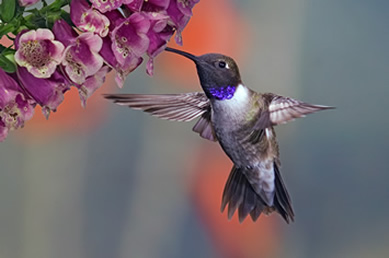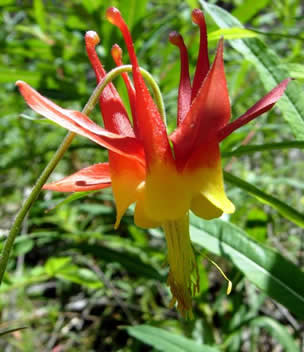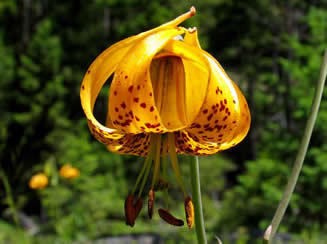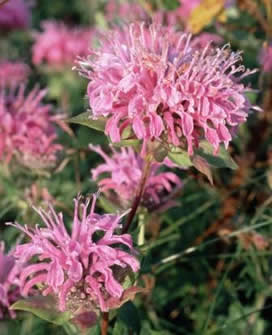|
NATURE NOTES

Black-chinned Hummingbird feeding on foxglove (Digitalis purpurea).
Photo by Alan Wilson.
Hummingbird Flowers of
British Columbia
by
Jim Pojar
Bulkley Valley Centre for Natural Resources
Research & Management
Abstract
Aquilegia formosa, Castilleja hispida var. hispida , C. miniata , C. rhexifolia, C. rupicola, Ipomopsis aggregata var. aggregata, Lonicera ciliosa, Ribes lobbii, and Stachys chamissonis var. cooleyae are the plant species in British Columbia which best fit the syndrome
of hummingbird pollination.Impatiens capensis, I. noli-tangere, Lilium columbianum, Lonicera dioica, Monarda fistulosa, Ribes sanguineum var. sanguineum, and
Rubus spectabilis have mixed or transitional pollination strategies, being
pollinated by both insects and hummingbirds. Examples of opportunistic
nectar foraging by hummingbirds are recorded for several other
species.
Introduction
Hummingbird flowers are defined by Grant and Grant (1968) as
flowers adapted primarily for feeding of and pollination by hummingbirds.
The syndrome of hummingbird pollination in western North
America includes several coadaptations. Well-developed hummingbird
flowers are usually solitary or loosely clustered, and are borne in a pendant
or more or less horizontal position. They frequently have deep tubular
corollas or are otherwise constructed to restrict access to the
very abundant nectar. The flowers are usually odourless, and most often
coloured a vivid red or orange, or red combined with yellow. Correspondingly,
hummingbirds hover while sipping nectar. They have long
bills and long, extensible tongues.
Hummingbirds have high energetic
requirements (Heinrich and Raven, 1972). They do not respond primarily
to floral odours, but they do perceive red and orange and recognize red flowers as signals of a high caloric reward. The common colour of
hummingbird flowers facilitates quick pollinator recognition but is not
conspicuous to insects (except butterflies) that could deplete the nectar
supply (Grant, 1966; Faegri and van de Pijl, 1971; Raven 1972).

Red-flowering currant (Ribes sanguineaum var. sanguineum).
Photo by Bill Jex.
The nectar and sexual organs of typical hummingbird flowers are
separated in such a way that pollen is usually deposited on the feathered
parts of the bird. Depending on the morphology of the flower and the
feeding orientation of the hummingbird, pollen may collect on the back
or top of the head, the upper or lower bill base, the chin, or the throat.
In flowers with short tubes and included sexual organs, pollen may be
transferred via the bill tips of hummingbirds. Studies of hummingbird
dispersal of pollen labeled with radioactive iodine indicate that
hummingbirds are extremely efficient vectors, at least within local populations
(Schlising and Turpin, 1971).
Feeding on small insects and floral nectar, hummingbirds migrate
northward to their breeding ranges in early spring as the flowering
season commences, and return southward to their wintering ranges in
late summer and early fall. Rufous hummingbirds (Selasophorus rufus)
are the commonest visitors, abundant throughout all but far northeastern
British Columbia. Calliope hummingbirds (Stellula calliope) are
common summer residents from the southern Interior to the Vanderhoof
area (Munro and Cowan, 1947). The black-chinned hummingbird
(Archilocus alexandri) is a scarce summer visitant to extreme southern
Interior British Columbia (Munro and Cowan, 1947). In the Victoria
area there have been sight records of the anna (Calypte anna) and costa (Calypte costa) hummingbirds (Godfrey, 1966; Mackenzie-Grieve and Tatum, 1974). [Editor's Note: View the current range for Anna's Hummingbird.]
The following plant species occur in British Columbia and conform
in most features to the syndrome of hummingbird pollination: Aquilegia formosa Fisch. ex DC. ssp. formosa, Castilleja hispida Benth., C. miniata Dougl. ex Hook, C. rhexifolia Rydb., C. rupicola Piper, Ipomopsis aggregata (Pursh) V. Grant var. aggregata, Lonicera ciliosa (Pursh) Poir ex DC., Ribes lobbii Gray,
Stachys chamissonis var. cooleyae Benth.

Sitka columbine (Aquilegia formosa ssp. formosa). Photo by Gordon Neish.
All of these species except Ribes lobbii were included by Grant and
Grant (1968) as definite hummingbird flowers. These authors also listed
Castilleja suksdorfii as a British Columbia hummingbird flower, but this
species does not occur in the Province (Hitchcock and Cronquist, 1973;
Taylor, 1974).
Ribes lobbii, a species of southwestern British Columbia south to
California, has pendant flowers with sharply reflexed, bright red calyx
lobes, a narrowly campanulate hypanthium, and well-exserted stamens
and styles. The adnate portion of the calyx and the anthers is also reddish.
Superficially, the flowers resemble miniature Fuchsia. The floral
mechanism appears similar to, but not as specialized as, that described
by Grant and Grant (1968 ) for Ribes speciosum, the Fuchsia-flowered
gooseberry of central southern California.
Several other species have floral mechanisms that diverge from the
syndrome of entomophily, and approach but do not attain the typical
condition of hummingbird flowers. It seems reasonable to view these
transitional mechanisms as mixed strategies for pollination, optimal
under present conditions.
Impatiens capensis Meerb. and I. noli-tangere L.
These closely related species of moist woods and thickets have
yellow to orange flowers that are often spotted or mottled with crimson
or reddish brown. The flowers are 2-3 cm long and have recurved,
nectariferous spurs. James (1948) noted that I. capensis (as its synonym,
I. biftora) was one of the summer flowers most commonly visited by
hummingbirds in the eastern United States. Knuth (1908) observed
visits by Bombus spp., vespid wasps, and halictid bees to I. noli-tangere in
Europe. In British Columbia, I have observed both hummingbirds and
bumblebees at the flowers of these jewelweeds.
Lilium columbianum Hanson ex. Baker
The tiger lily's pendant flowers have six strongly recurved sepals that
are yellow-orange to reddish-orange, spotted with deep red or purple.
Both style and stamens are well exserted. Nectar is secreted between
the base of the ovary and the tepals. The tepals lack the nectar slits described in other similar Lilium species by Knuth (1909) and Proctor
and Yeo (1973). In British Columbia, hummingbirds and various
Lepidoptera are common visitors to the flowers of L. columbianum. In
California, two species of Lilium have evolved to specialized hummingbird
pollination, whereas another species (L. humboldtii) is similar to
L. columbianum in being visited by both butterflies and hummingbirds
(Grant and Grant, 1968).

Columbia lily (
Lilium columbianum). Photo by Werner Eigelsreiter.
Lonicera dioica var. glaucescen L.
This taxon occurs in the far southeastern and northeastern regions of the Province. It flowers are similar to those of Lonicera ciliosa, but the corolla is more strongly bilabiate, yellowish to purplish or reddish rather than orange-red, and the corolla tube is shorter (up to 3 cm x 2.5-4 cm). I have seen ruby-throated hummingbirds visiting L. dioica in Minnesota, and it is probably also frequently pollinated by bees and butterflies
A shift to hummingbird pollination can also be seen in Lonicera involucrata (Rich.) Banks var. ledebourii (Each.) Jeps., a variety of the southern
Oregon and northern California coasts. It has reddish-tinged corollas
up to 2 cm long instead of the typical yellow 1- 1.5 cm long corollas.
The bright-red involucral bracts are additional attractive features. Grant
and Grant (1968) include it as a hummingbird flower, whereas typical L.
involucrata is pollinated in British Columbia primarily by bumblebees,
butterflies, and moths, and only occasionally by hummingbirds.
Monarda fistulosa L.
This taxon is listed by Grant and Grant (1968) as a definite
hummingbird flower, but in British Columbia it is visited by butterflies
and bumblebees as well. The 2.5-3.5 cm long, lavender-purple flowers
are borne more or less horizontally in dense, terminal heads. The related
Oswego tea, Monarda didyma, familiar to gardeners, has longer,
crimson corollas and is a better developed hummingbird flower (see
James, 1948).
Ribes sanguineum Pursh var. sanguineum
The flowering of this beautiful currant usually heralds the spring
arrival of the first migrating rufous hummingbirds along British Columbia's
southern coast. The pale rose to crimson flowers are clustered in
hanging racemes. Each flower has a tubular-campanulate hypanthium
3-5 mm long surmounted by spreading calyx lobes of about the same
length. The five petals and stamens are slightly shorter than the sepals
and are borne near the top of the hypanthium in a loose ring. The
styles are about as long as the sepals and are slightly exserted from the
rest of the flower. The short total length of the flower (no more than
10 cm from stigmas to hypanthium base) and the positioning of the
sexual organs probably result in bill tip or bill base pollen transfer by
hummingbirds. The flowers have abundant nectar but only a faint spicysweet
fragrance (a strong odour of wild currant is general to the plant).
I have observed both hummingbirds and bumblebees nectar-feeding on
Ribes sanguineum. Rufous hummingbird visits have also been observed
in British Columbia by Pillsbury (1950). The red flowering currant is a
highly prized ornamental shrub in many other countries, and it is noteworthy
that Proctor and Yeo (1973) mention titmice (Parus) thieving
nectar from cultivated R. sanguineum in Britain.

Wild bergamot (Monarda fistulosa). Photo by Jim Pojar.
Rubus spectabilis Pursh
Salmonberry flowers are another good example of a partial shift
toward hummingbird pollination in a genus that is predominantly entomophilous.
Like Ribes sanguineum, its flowering is correlated with the
arrival of migrating rufous hummingbirds along the Pacific coast from
northwestern California to southwestern Alaska. The showy, red to
reddish-purple petals are up to 30 mm long and form a shallow, downturned
bell. The numerous stamens arch up over the receptacle to form
a cone; they do not lie flat against the petals as in most species of Rubus.
The flowers are copiously nectariferous between the receptacle and
the filaments, but only mildly sweet-smelling. Again, as with Ribes sanguineum var. sanguineum,
I have observed both hummingbird and bumblebee visits to
salmonberry flowers. Meeuse (1972), in a review of Faegri and van der
Pijl's 1971 text, remarks that "…the flowers of Rubus spectabilis, certainly among the showiest of all Rubi, are very rich in nectar indeed. In
this plant…color and the possession of much nectar, simply form part
of a whole complex of characters that appear to stimulate hummingbird
pollination."
Hummingbirds are notorious for their weakly selective, opportunistic
choice of a wide variety of nectar sources. It is not surprising that in
British Columbia, with a flora poor in specialized hummingbird flowers,
the birds can be seen taking nectar from many different primarily entomophilous
species. Some flowers which I have seen hummingbirds
visit in British Columbia include the primarily bombophilous Castilleja
unalaschensis, Mimulus lewisii, and Pedicularis bracteosa [also observed
on Mount Rainier by Macior (1973)]; the abundantly nectariferous but
relatively small-flowered, ericaceous Arbutus menziesii, Arctostaphylos
columbiana, and Gaultheria shallon; as well as the entomophilous species
Delphinium nuttallianum, Epilobium angustifolium, Lythrum salicaria,
and Oemlaria cerasiformis. Calliope hummingbirds have been
observed taking nectar from the catkins of a species of Salix, and from
the flowers of Arctostaphylos uva-ursi in the Jesmond area (Cariboo District)
in May 1974 (R.A. Pojar, pers. comm.). In visiting A. uva-ursi,
the hummingbirds alighted momentarily to probe the low flowers while
flying from plant to plant. Many entomophilous cultivated plants such
as Aesculus hippocastanum, A. ×carneum, Buddleja davidii, and species
of Aconitum, Delphinium, Pelargonium and Rhododendron, among
others, are also frequently visited. This feeding promiscuity extends
even to sap-filled flicker holes in the trunks of Betula papyrifera. Undoubtedly,
careful observation will discover more examples of unusual
hummingbird behaviour.
Reprinted from the original article (Syesis 8:25-28. 1975), with permission.
[Editor's note: Since this article was written in 1975, the Ruby-throated Hummingbird is now present in BC.]

Salmonberry (Rubus spectabilis). Photo by Jim Pojar.
References
Faegri, K., and van der Pijl, L. (1971). The Principles of Pollination Ecology,
2d rev. ed. Pergamon Press, Toronto. 291 p.
Godfrey, W.E. (1966). The Birds of Canada. Nat. Mus. Can. Bull. No. 203.
Ottawa.
Grant, K.A. (1966). A hypothesis concerning the prevalence of red coloration
in California hummingbird flowers. Amer. Natur., 100:85-97.
Grant, K.A., and Grant, V. (1968). Hummingbirds and Their Flowers. Columbia
Univ. Press, NewYork and London. 115 p.
Heinrich, B., and Raven, P.H. (1972). Energetics and pollination ecology. Science,
176:597-602.
Hitchcock, C.L., and Cronquist, A. (1973). Flora of the Pacific Northwest.
Univ. Wash. Press, Seattle. 730 p.
James, R.L. (1948). Some hummingbird flowers east of the Missippi. Castanea,
13:97-109.
Knuth, P. (1906-09). Handbook of Flower Pollination. Trans. J, R. Ainsworth
Davis. (3 vol.: I, 1906; II, 1908; III, 1909). Oxford.
Mackenzie-Grieve, R.C., and TATUM, J.B. (1974). Costa's hummingbird, a
new bird for Canada. Can. Field-Nat., 88:91-92.
Macior, L.W. (1973). The pollination ecology of Pedicularis on Mount Rainier.
Amer. J. Bot., 60:863-871.
Meeuse, B.J.D. (1972). Pollination ecology. Ecology, 53:984-986.
Munro, J.A., and COWAN, I. McT. (1947). A Review of the Bird Fauna of British
Columbia. British Columbia Prov. Mus. Spec. Publ. No. 2. 285 p.
Pillsbury, R.W. (1950). Early spring feeding of the rufous hummingbird on the
coast of southern British Columbia. Murrelet, 31:45.
Proctor, M., and YEO, P. (1973). The Pollination of Flowers. Collins, London.
418 p.
Raven, P.H. (1972). Why are bird-visited flowers predominantly red? Evolution,
26:674.
Schlising, R.A., and TURPIN, R.A. (1971). Hummingbird dispersal of Delphinium
cardinale pollen treated with radioactive iodine. Amer. J. Bot.,58:401-
406.
Taylor, T.M.C. (1974). The Figwort Family (Scrophulariacece) of British Columbia.
British Columbia Prov. Mus. Handbook No. 33. 237 p.
|